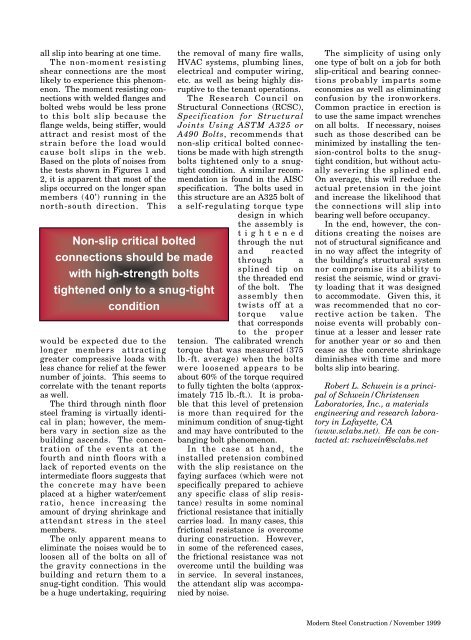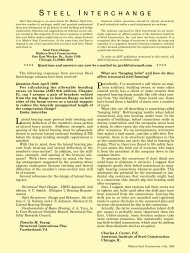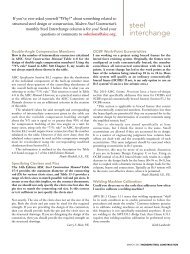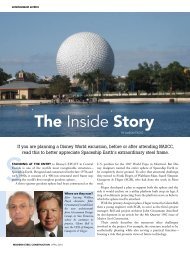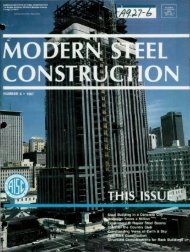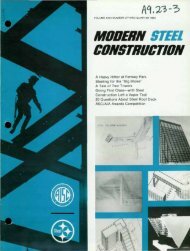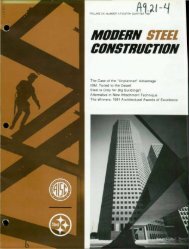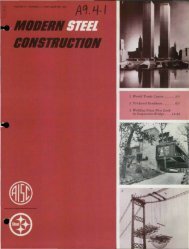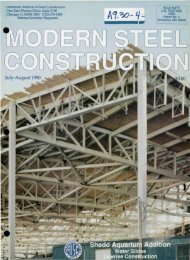THE BANGING BOLT SYNDROME - Modern Steel Construction
THE BANGING BOLT SYNDROME - Modern Steel Construction
THE BANGING BOLT SYNDROME - Modern Steel Construction
Create successful ePaper yourself
Turn your PDF publications into a flip-book with our unique Google optimized e-Paper software.
all slip into bearing at one time.<br />
The non-moment resisting<br />
shear connections are the most<br />
likely to experience this phenomenon.<br />
The moment resisting connections<br />
with welded flanges and<br />
bolted webs would be less prone<br />
to this bolt slip because the<br />
flange welds, being stiffer, would<br />
attract and resist most of the<br />
strain before the load would<br />
cause bolt slips in the web.<br />
Based on the plots of noises from<br />
the tests shown in Figures 1 and<br />
2, it is apparent that most of the<br />
slips occurred on the longer span<br />
members (40’) running in the<br />
north-south direction. This<br />
Non-slip critical bolted<br />
connections should be made<br />
with high-strength bolts<br />
tightened only to a snug-tight<br />
condition<br />
would be expected due to the<br />
longer members attracting<br />
greater compressive loads with<br />
less chance for relief at the fewer<br />
number of joints. This seems to<br />
correlate with the tenant reports<br />
as well.<br />
The third through ninth floor<br />
steel framing is virtually identical<br />
in plan; however, the members<br />
vary in section size as the<br />
building ascends. The concentration<br />
of the events at the<br />
fourth and ninth floors with a<br />
lack of reported events on the<br />
intermediate floors suggests that<br />
the concrete may have been<br />
placed at a higher water/cement<br />
ratio, hence increasing the<br />
amount of drying shrinkage and<br />
attendant stress in the steel<br />
members.<br />
The only apparent means to<br />
eliminate the noises would be to<br />
loosen all of the bolts on all of<br />
the gravity connections in the<br />
building and return them to a<br />
snug-tight condition. This would<br />
be a huge undertaking, requiring<br />
the removal of many fire walls,<br />
HVAC systems, plumbing lines,<br />
electrical and computer wiring,<br />
etc. as well as being highly disruptive<br />
to the tenant operations.<br />
The Research Council on<br />
Structural Connections (RCSC),<br />
Specification for Structural<br />
Joints Using ASTM A325 or<br />
A490 Bolts, recommends that<br />
non-slip critical bolted connections<br />
be made with high strength<br />
bolts tightened only to a snugtight<br />
condition. A similar recommendation<br />
is found in the AISC<br />
specification. The bolts used in<br />
this structure are an A325 bolt of<br />
a self-regulating torque type<br />
design in which<br />
the assembly is<br />
tightened<br />
through the nut<br />
and reacted<br />
through a<br />
splined tip on<br />
the threaded end<br />
of the bolt. The<br />
assembly then<br />
twists off at a<br />
torque value<br />
that corresponds<br />
to the proper<br />
tension. The calibrated wrench<br />
torque that was measured (375<br />
lb.-ft. average) when the bolts<br />
were loosened appears to be<br />
about 60% of the torque required<br />
to fully tighten the bolts (approximately<br />
715 lb.-ft.). It is probable<br />
that this level of pretension<br />
is more than required for the<br />
minimum condition of snug-tight<br />
and may have contributed to the<br />
banging bolt phenomenon.<br />
In the case at hand, the<br />
installed pretension combined<br />
with the slip resistance on the<br />
faying surfaces (which were not<br />
specifically prepared to achieve<br />
any specific class of slip resistance)<br />
results in some nominal<br />
frictional resistance that initially<br />
carries load. In many cases, this<br />
frictional resistance is overcome<br />
during construction. However,<br />
in some of the referenced cases,<br />
the frictional resistance was not<br />
overcome until the building was<br />
in service. In several instances,<br />
the attendant slip was accompanied<br />
by noise.<br />
The simplicity of using only<br />
one type of bolt on a job for both<br />
slip-critical and bearing connections<br />
probably imparts some<br />
economies as well as eliminating<br />
confusion by the ironworkers.<br />
Common practice in erection is<br />
to use the same impact wrenches<br />
on all bolts. If necessary, noises<br />
such as those described can be<br />
minimized by installing the tension-control<br />
bolts to the snugtight<br />
condition, but without actually<br />
severing the splined end.<br />
On average, this will reduce the<br />
actual pretension in the joint<br />
and increase the likelihood that<br />
the connections will slip into<br />
bearing well before occupancy.<br />
In the end, however, the conditions<br />
creating the noises are<br />
not of structural significance and<br />
in no way affect the integrity of<br />
the building’s structural system<br />
nor compromise its ability to<br />
resist the seismic, wind or gravity<br />
loading that it was designed<br />
to accommodate. Given this, it<br />
was recommended that no corrective<br />
action be taken. The<br />
noise events will probably continue<br />
at a lesser and lesser rate<br />
for another year or so and then<br />
cease as the concrete shrinkage<br />
diminishes with time and more<br />
bolts slip into bearing.<br />
Robert L. Schwein is a principal<br />
of Schwein/Christensen<br />
Laboratories, Inc., a materials<br />
engineering and research laboratory<br />
in Lafayette, CA<br />
(www.sclabs.net). He can be contacted<br />
at: rschwein@sclabs.net<br />
<strong>Modern</strong> <strong>Steel</strong> <strong>Construction</strong> / November 1999


